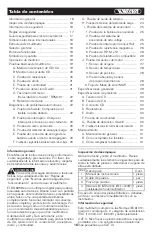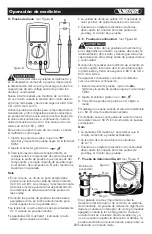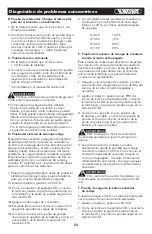
figure 11
Red
Black
Spark plug
Diagnosis of automotive Troubles
9
H. Charging System Voltage Testing
This testing is used to see if the charging system
operates normally so as to provide the electronic
systems with adequate power (lamps, electric
fans, radio sets, etc.).
1. Set the rotary switch of the multimeter to the
20VDC As prompted at the LCD connect
terminal, insert the red test lead into the V
terminal and the black one into the COM
terminal.
2. Connect the black test lead probe to the
negative pole of the battery and the red one to
the positive pole of the battery.
3. Run the engine idle and close or turn off all the
accessories with the normal voltage readings
being 13.2 V to 15.2 v.
4. Open the throttle and control the rotation speed
of the engine between 1800 RPM and 2800
RPM. The voltage readings should be
consistent with those in (3) (with the difference
being no more than 0.5 V).
5. Turn on the lamps, windshield wipers, fans and
so on to increase the loads of the electronic
systems with the voltage readings being no less
than 13.0 V.
6. If the readings in Steps 3., 4. and 5. are normal,
the charging system is also normal. If the
readings in Steps 3., 4. and 5. are beyond the
limits or inconsistent with those in the operation
manual, check the current ranges of the
conveying belt, regulator, AC generator,
connector and open-circuit AC generator. If any
further diagnosis is required, refer to various
kinds of automotive manuals.
I. Ignition System Testing
1. Ignition Coil Testing
(1) Before the operation, cool the engine and cut
off the ignition coil.
(2) Set the rotary switch of the meter to the 200
Ω
.
As prompted at the LCD connect terminal,
insert the red test lead into the
Ω
terminal and
the black one into the COM terminal. Test the
primary coil of the ignition coil.
(3) Short circuit the red and black test lead probes.
Their short circuit resistance should be less
than 0.5
Ω
. If it is more, check the test lead to
see if it is loose or damaged. If it is damaged,
replace it with a new one.
(4) Connect the red test lead probe to the primary
“+” pole of the ignition coil and the black one
to the primary “-” pole of the coil. (see figure
10.) See the detailed positions in various kinds
of automotive manuals.
(5) Set the rotary switch to the 200k
Ω
and test
the secondary coil of the ignition coil.
(6) Connect the red test lead probe to the
secondary outlet and the black one to the
primary “-” pole. Refer to various kinds of
automotive manuals for the details.
(7) The secondary resistance is generally in a
range of 6 k
Ω
to 30 k
Ω
. Refer to various kinds
of automotive manuals for the details.
(8) For a heater ignition coil, repeat the said testing
steps.
Note:
For a heater ignition coil, the resistance may be
a little higher because the resistance of a coil will
vary with the temperatures. The higher the
temperature, the higher the resistance will be and
vice versa.
• The reading of the testing becomes the
actual tested resistance only after the reduction of
the shortcircuit values of the test leads.
• Some of Chrysler’s products use a spark
plug high voltage damper with “positive lock” end
electrodes, which can only be moved out of the
distributor board. If it is moved out of anywhere
else, some damage will result. Refer to various
kinds of automotive manuals for the details.
• The primary resistance is generally between
0.3
Ω
and 2.0
Ω
.
(2) Set the rotary switch of the meter to the 200 k
Ω
.
As prompted at the LCD connect terminal, insert
the red test lead into the
Ω
terminal and the
black one into the COM terminal.
WARNING
WARNING
figure 10
Cylindrical Ignition Coil
Primary
Coil
Secondary
Coil
Black
Red
2. Ignition System High-Voltage Damper Testing
(see figure 11)
(1) Move the connectors of the ignition system
from the engine. Refer to the ignition system
movement procedure in various kinds of
automotive manuals for the details.
Содержание KN 8056
Страница 1: ...KN 8056 Digital automotive multimeter Mult metro digital automotriz...
Страница 33: ...Notes Notas...
Страница 34: ...www knova com mx...











































